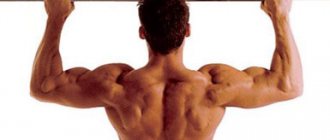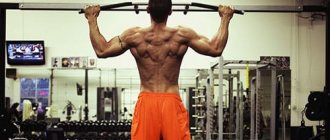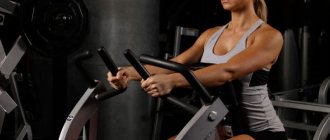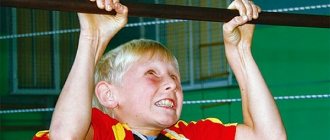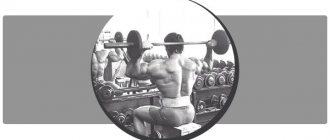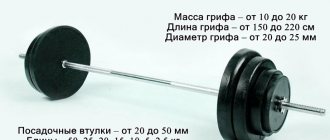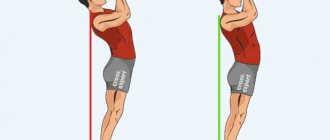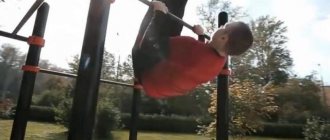Pull-ups on the horizontal bar are accessible to everyone, and most importantly, a very effective exercise for the muscles of the chest, back, shoulder girdle and abs. In addition, an important advantage of such classes is that you do not have to buy expensive exercise equipment or purchase gym memberships - now there are horizontal bars in almost every yard, children's and sports grounds are equipped with them, and they are publicly available.
However, just the desire to do pull-ups on the horizontal bar is not enough; it is very important to understand: your result will directly depend on the technique, on how correctly the exercise is performed.
How to do pull-ups correctly - basic rules
There are two types of pull-up techniques.
The first is for passing standards, and the second is performing an exercise with the goal of pumping up certain muscle groups. This type of technique is actively used in bodybuilding.
Pull-up technique for passing the standard
So, let’s look at the rules for doing pull-ups on the horizontal bar to pass the standard:
- Starting position – hanging on the crossbar. Hands slightly wider than shoulders, straight grip, palms facing away (reverse grip is not allowed).
- Pull up until your chin touches the bar.
- Smoothly lower down until full straightening in the elbow and shoulder joints.
- During the exercise, keep your legs together, knees bent or straight.
- Help from the legs and torso is prohibited (without inertia or swing).
Such strict rules when passing the standard on the horizontal bar are designed to provide equal conditions for everyone.
Pull-up technique in bodybuilding
Another thing is the pull-up technique in the gym.
The main goal here is to work out the muscles. Therefore, the rules for performing the exercise are radically different.
For example, consider the technique of wide-grip pull-ups to the chest:
- In the starting position, the arms are slightly bent to create additional tension in the latissimus muscles.
- At the start, the pelvis moves slightly forward, and the shoulders lean back. The chest is brought forward and upward.
- The movement begins with bringing the shoulder blades together, that is, the emphasis is placed on the back muscles.
- Bend your elbows and reach the top point (before your chest touches the bar), smoothly return to the starting position without fully extending your arms.
What should you definitely remember?
- Don't let your body sway while doing pull-ups, learn to control it;
- Perform the exercise smoothly and slowly, without jerks or sudden descents;
- Try to stretch your chin up. The exercise is considered completed when the chin is above the horizontal bar;
- Breathe evenly, watch your breathing. When you stretch up, exhale, while lowering, inhale;
- Hold on to the horizontal bar tightly. If your hands sweat, use sports magnesium (it can be replaced with chalk, talcum powder and even starch);
- Complete the exercise before muscle failure occurs. During pull-ups, it is important to monitor the technique of performing the exercise. If you feel that you are no longer lifting high enough, you are starting to pull yourself up crookedly, or you are slowing down, it’s time to end the exercise;
- Don't perform the exercise by always using the same grip. Any new load is stress for the body, giving a signal for the beginning of muscle growth. However, if you always use the same grip, the muscles get used to such a load and, as a result, stop growing. Therefore, try to change your grip or grip width every one and a half to two months;
- Vary the number of sets and reps per set to keep your muscles from adapting and stopping growing. You can alternate training with a high number of repetitions, aimed at increasing endurance, with training with a low number of repetitions, but with weights - to increase strength;
- Use an expander to strengthen your grip and make your hands stronger;
- Give your muscles enough time to rest and recover, don't overload them every day. Ideally, you should do two to three workouts per week;
- If you are just learning how to do pull-ups, do not use a wide grip, as it is considered the most difficult;
- Do not jerk your head back when starting to move your torso upward, so as not to injure the cervical vertebrae;
- Don't arch your back. Many people do pull-ups with an arched back, but this can be dangerous. To fix your back in the correct position, tense your stomach as if you were about to be hit;
- Squeeze your hips and squeeze your buttocks - this will allow you to sway less.
Types of grips for pull-ups
There are many variations of pull-ups on the horizontal bar. Depending on the width and grip, the load shifts to different muscle bundles.
Main types of grips:
- Reverse grip (underhand grip, palms facing you)
The easiest and most affordable version of pull-ups. Here the biceps are included in the work as much as possible.
- Straight grip (overhead, palms facing away from you)
Here the load is evenly distributed across the working muscles - the latissimus, biceps, forearms.
- Wide straight grip to the chest
The emphasis of the load shifts to the lats.
- Wide straight head grip
The lats also work well. But if there is insufficient mobility of the thoracic region, this grip can overload the shoulder joints.
- Parallel grip to the chest (palms facing each other)
For such pull-ups, a special handle is used. The latissimus dorsi muscles are actively involved in the work, with an emphasis on the middle and lower sectors.
Recommendations
We would like to give you some useful tips that will help you make your training safer and more effective.
- Always warm up. Regardless of what goal you set for yourself (increasing muscle mass, working on strength, increasing the number of repetitions), be sure to warm up before each sports activity. During it, you not only warm up and bring the body into the tone necessary for training, but also prepare your muscles and joints for subsequent loads.
- Don't exercise every day. Many novice athletes mistakenly believe that the more often they train, the faster they will achieve their goal. This is wrong. If you pull yourself to failure every day, this will quickly lead to a drop in strength and fatigue. That is why it is important to train according to a well-designed program, in which there is a balance between training days and rest days (an example of such a program is presented earlier in the article).
- Do the exercises correctly. Incorrect technique is one of the main reasons why many beginners get injured and do not achieve the desired results. If you have such an opportunity, ask a more experienced athlete to monitor your technique and, if necessary, give you recommendations regarding execution.
- Eat right. This advice applies not so much to training on the horizontal bar, but to playing sports in general. It doesn’t matter how you train—for weight, for strength, or for endurance—in any case, you need a healthy diet containing plenty of high-quality proteins, fats, and carbohydrates.
In the article, we looked at the types of pull-ups on the horizontal bar and the muscle groups that they use. We hope that the information provided in it was informative and you received answers to your questions. The main thing is not to forget that the technique of execution is the decisive factor in achieving the desired goal.
Common mistakes in technology
Correctly doing pull-ups on the horizontal bar is quite simple. However, there are often technical errors here.
The most common mistakes when doing pull-ups:
- Jerky, inertial upward movements
The movement is performed not by muscle power, but by speed and inertia. Muscle work with this technique is minimal.
- Quick descent.
For muscle hypertrophy (growth), not only the ascent phase is important, but also the descent phase. By “falling” down, you deprive the muscles of a significant part of the load.
- Incomplete range of motion
By limiting the amplitude of the exercise, the muscles are pumped only in a certain area. Long-term use of this technique contributes to muscle shortening, which is unacceptable from an aesthetic point of view.
- Improper breathing
Leads to an increase in pressure and impairs the supply of oxygen to tissues.
Tips for choosing a crossbar
When choosing a horizontal bar, you need to look at:
- what material it is made of;
- what types of grip is it suitable for?
- Are the handles well made?
It is better to give preference to metal products. The ideal option is metal pipes 2-3 cm thick. The hand should tightly grasp the pipe - this is the key to a successful exercise. Each modern horizontal bar provides a lower and upper grip; some models provide a narrow and wide grip. To prevent your hand from slipping and causing calluses, it is better to purchase devices with a rubberized surface.
Kinds
First you need to determine where the crossbar for pulling up the house will be located. For small apartments, a crossbar in the doorway would be an excellent option. If there is enough space in the house, you can install a floor structure. There are various models for a doorway or passage, as well as universal horizontal bars.
They come in three types:
- sliding;
- standard (with anchor fastening);
- removable.
Such devices are compact, but not entirely functional. If there is free corner space, you can install a horizontal bar with anchor fastening in the corner. If space allows, ceiling installation would be a good option. Many people prefer standard hanging horizontal bars. They are easy to install, compact and allow you to do a variety of exercises. Such designs can be purchased in various variations.
Best models
For effective training you will need parallel bars. They are:
- stationary;
- collapsible;
- removable;
- strengthened;
- may have a back and armrest;
- bars combined with a horizontal bar.
The design of these products is quite simple; high-quality and safe materials are used for their manufacture. All devices can withstand loads of up to 150 kg.
The best models include the following devices.
- EffectSport 3 in 1. This is a removable design, attached to a special frame. It is a universal exercise machine that allows you to pump up your chest, back, arms and abs. Refers to mounted structures, made of steel, can withstand up to 150 kg.
- Horizontal bar with a boxing bag. The frame has a special hole for installing a swing or punching bag. This is a fairly simple but effective exercise machine for various muscle groups. It is wall-mounted, can withstand up to 150 kg, and is made of metal and neoprene.
- BradexWorkout. Adjustable, spacer horizontal bar, can withstand up to 90 kg, made of steel and polyurethane.
- EffectSport ceiling crossbar. A very compact device, but not suitable for every room. The steel structure can withstand up to 200 kg.
- Bradex hanging horizontal bar. The device can be used even without attaching it to the wall; it is convenient to swing and do push-ups. The versatility of the crossbar makes it possible to do a variety of exercises. The structure is made of combined materials (metal, foamed polymer and plastic) and can withstand up to 105 kg.
All of these models are among the best on the sporting goods market. They are suitable for an apartment and a gym.
Basics of proper breathing when doing pull-ups
When doing pull-ups on the horizontal bar, proper breathing plays an important role.
Basics of proper breathing:
- Take a short breath at the start
- The upward movement begins while holding your breath
- Having reached the middle of the amplitude, we exhale
- The end of the exhalation should coincide with the final point of the movement
- We lower ourselves smoothly and under control to the starting position, taking a smooth breath as we move.
You absolutely cannot hold your breath completely! This can cause increased blood pressure and poor health.
Half-Moon or one-arm pull-up
This pull-up is practiced in preparation for one-arm pull-ups. A neutral grip or pronation is suitable for this exercise.
Starting position: hanging with arms straight and relaxed. The body is pulled up only on the right or only on the left hand. The second one is “stretched” at this time, as a result of which the line of the arms and shoulders forms a “half moon”. After mastering this type of pull-up, you can move on to one-arm pull-ups.


